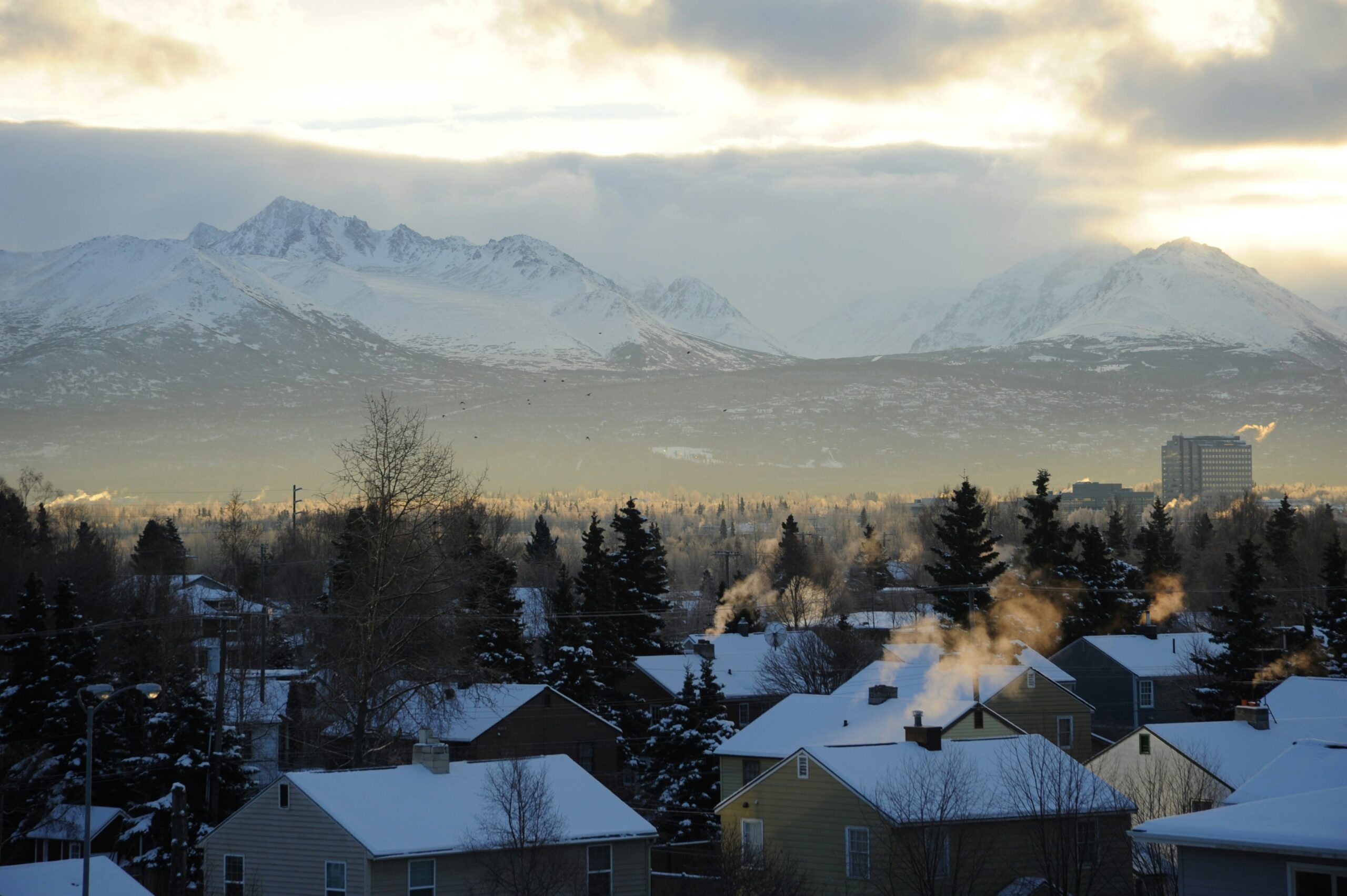The Anchorage Assembly has removed major impediments in city building and land use rules that have long discouraged builders from putting up tri- and fourplexes. The changes are the latest in a series of reforms that could spur more infill housing in a wider variety of styles and price points in Alaska’s largest city.
City code saddled tri- and fourplexes with a raft of extra requirements, like having to pave over enough land for a vehicle to make a three-point turn. They were also subject to extra landscaping, lighting, drainage, and architectural requirements. A one- or two-unit home on the same lot of the same size or even larger, even if built to house fewer people, didn’t have the same requirements, making them cheaper to build.
No surprise, then, that Anchorage developers have been leaving a significant number of units on the table. No more than five triplexes have gone up in Anchorage in a single year since 2001, according to data provided by affordable housing developer Cook Inlet Housing Authority. Some years, no developer has built a single triplex.
A working group consisting of officials from across the municipality, from the fire marshal to the planning department, along with local developers and community members, spent about a year hammering out changes. They consulted with officials from Shelby County, Tennessee, which reclassified structures of three to six units as residential instead of commercial under its building code. The process resulted in two sets of reforms, one in the municipal land use code (Title 21) and the other in the building code (Title 23).
Developers have long known about the regulatory impediments to small multifamily homes. But only in the last couple years have high home prices, low inventory, a homelessness crisis, a trend toward smaller, more numerous households, and a shrinking working-age population propelled these and other housing supply fixes to the forefront of city priorities.
The land use and building code reforms for tri- and fourplexes are the latest in a series of pro-housing ordinances passed with healthy majorities in the 12-member assembly. The assembly has done away with parking requirements, removed key regulatory barriers to accessory dwelling units, and changed zoning rules to encourage more residential construction downtown. In October 2023, the assembly hosted Housing Action Week headlined by Charles Marohn of the urban reform organization Strong Towns and unveiled a strategic action plan for housing. It’s considering further changes in the summer of 2024 to bring zoning rules into greater conformance with the pro-housing goals stated in Anchorage’s 2040 Land Use Plan.
Both ordinances went into effect in January 2024. But before construction can really get going, developers are waiting for additional action by the city to change drainage requirements and walk back rules passed this summer dictating where on a site parking is allowed.
Land use changes will treat small multifamily more like single-family homes
In an 11–1 vote, the assembly on December 19 passed updates to Anchorage zoning code that eliminated a few of the major differences between how Anchorage code treats single-detached (a.k.a. “single-family”) homes and small multifamily homes.
The minimum lot size for triplexes now matches that of single-family homes and duplexes in a residential zone known as “R-2M,” where triplexes are already allowed. Triplexes can go up on lots measuring 6,000 square feet or more, where they previously required an 8,500-square-foot lot. R-2M zones exist throughout the city: along the Chester Creek greenbelt and near Westchester Lagoon, the U-Med district and Campbell tract, Sand Lake and Campbell Lake, and Muldoon.
The assembly also changed the allowed gross density of R-2M to 30 dwelling units per acre in accordance with Anchorage’s 2040 Land Use Plan.
The reforms treat tri- and fourplexes like single-detached houses in other ways:
- In all districts, the height limit for homes with fewer than four units is 30 feet, regardless of the number of stories.
- They now are subject to the same residential design standards as one- and two-unit homes rather than the multifamily and townhouse design standards.
- Three- and four-unit developments no longer need to provide the city with a warranty guarantee their landscaping will survive.
- In the R-2M zone, any single structure larger than 5,000 square feet requires a 10-foot front setback, no matter how many units it contains. Otherwise, a 5-foot front setback applies.
Finally, on the land use side, a separate wide-ranging ordinance on parking and site access contained changes relevant to tri- and fourplexes. In July 2023, the assembly modified a requirement that tri- and fourplex homes have a large enough driveway to allow for a three-point turn. Now, the city will allow multifamily homes to have the same driveways as those single-detached homes, where cars pull in and back out. But the driveways must be on a local street and cannot be wider than 20 feet. It’s an improvement over the old rules because the cost of paving over a substantial amount of square footage and designing homes around sprawling driveways is a huge deterrent to small multifamily homes and not required for single-detached or duplex homes.
Updates to Anchorage building code
On the building code side, the reforms reclassify triplexes as residential construction and allow independent professional plan reviewers to ensure triplexes comply with building code, an option already available to one- and two-unit projects.
The assembly did not include fourplexes in all the building code changes since Alaska doesn’t allow local jurisdictions to override the status of fourplexes as commercial on the building code side. The Alaska Legislature, however, could act to have fourplexes recategorized as residential rather than commercial. The Washington State Legislature is considering a similar change that would reclassify homes up to six units as residential. These homes would then need to meet standards set under the International Residential Code, rather than the International Building Code, as is currently the case.
Assembly member Kevin Cross called fourplexes “the platypus of real estate” while discussing the ordinance at a special assembly meeting before unanimous passage on January 16. Cross, who represents Eagle River, sponsored the set of ordinances along with Daniel Volland (Downtown and Fairview) and Randy Sulte (South Anchorage and Girdwood).
Cross noted that code-wise, fourplexes are commercial, but federal housing finance agencies such as the US Department of Housing and Urban Development and Veteran’s Administration, as well as private financial institutions and local zoning codes, recognize them as residential.
“So we treat them as kind of in between, and they end up getting bogged down and not built,” Cross said.
Still, the assembly was able to establish uniform permitting fees for homes with four or fewer units. And, based on close consultation with the fire marshal and other fire safety professionals, the assembly enacted a sprinkler standard that costs less while maintaining life and safety standards. Specifically, the building code no longer requires sprinkler heads in spaces smaller than 55 square feet, like closets and bathrooms. The modified rule reduces construction costs by allowing for narrower water lines.
“Bringing in a two- or three-inch water line made the cost of building fourplexes oppressive,” Cross noted. “Most of these now can be built with a standard ¾- or 1-inch water line.”
The assembly also passed resolutions asking the Development Services department to propose, over the next 6 months, amendments to the city’s Design Criteria Manual that align fourplex construction requirements with residential construction. And in the meantime, permit reviews for projects with four or fewer units should go through the residential process, which is presumably shorter than the commercial one. The department also must establish a process for fourplex permitting and plan review workflows that is simpler and faster than the usual workflow for commercial construction.
“It shouldn’t take as long as it would take, say, 15 or 20 units, to build a small, residential multifamily property,” Cross noted.
Crucial changes still needed for parking and drainage
Developers are still looking to city departments to make the following changes before the snow melts and the 2024 building season begins:
- Rolling back a design requirement passed in the parking and site access ordinance in July that limits on-site parking in front of new multifamily buildings. Multifamily builders note that the new rule takes away their flexibility on parking layout and say existing successful projects could not have gone up had this rule been in place when they were built.
- Dropping automatic requirements that tri- and fourplex projects provide drainage plans, which are costly and time-consuming, and instead base the need for a drainage plan on a project’s square footage.
Making way for expanded housing choice and affordability in Anchorage
Housing developers have long noted that the extra costs and time required to build anything larger than a duplex essentially forced them to build fewer housing units on lots that could have accommodated more. In 2019, a triplex design contest staged in Fairview by Cook Inlet Housing Authority surfaced multiple ways the land use and building codes made small multifamily homes significantly more expensive to build than one- and two-unit homes of the same size.
Single-unit properties on large lots dominate the Anchorage housing market, driving up costs for anyone looking to buy or rent. Of the occupied housing units in Anchorage, 80,274 are single-detached homes, according to the 5-year American Community Survey in 2020. Combined, the six other housing types counted in census data, including duplexes, triplexes, townhomes, and mobile homes, account for the other 58,660 homes.
“We’ve spent years writing codes and local policies that make it challenging to build anything over a duplex in our multi-family zoned urban neighborhoods. It’s taking equally as long to unravel this web of rules that are making it hard for homebuilders and affordable housing providers to meet Anchorage’s housing needs,” said Tyler Robinson, vice president of community development, planning, and real estate at Cook Inlet Housing. “This is an important step and most importantly demonstrates the political will to ensure that we keep removing regulatory barriers.”









